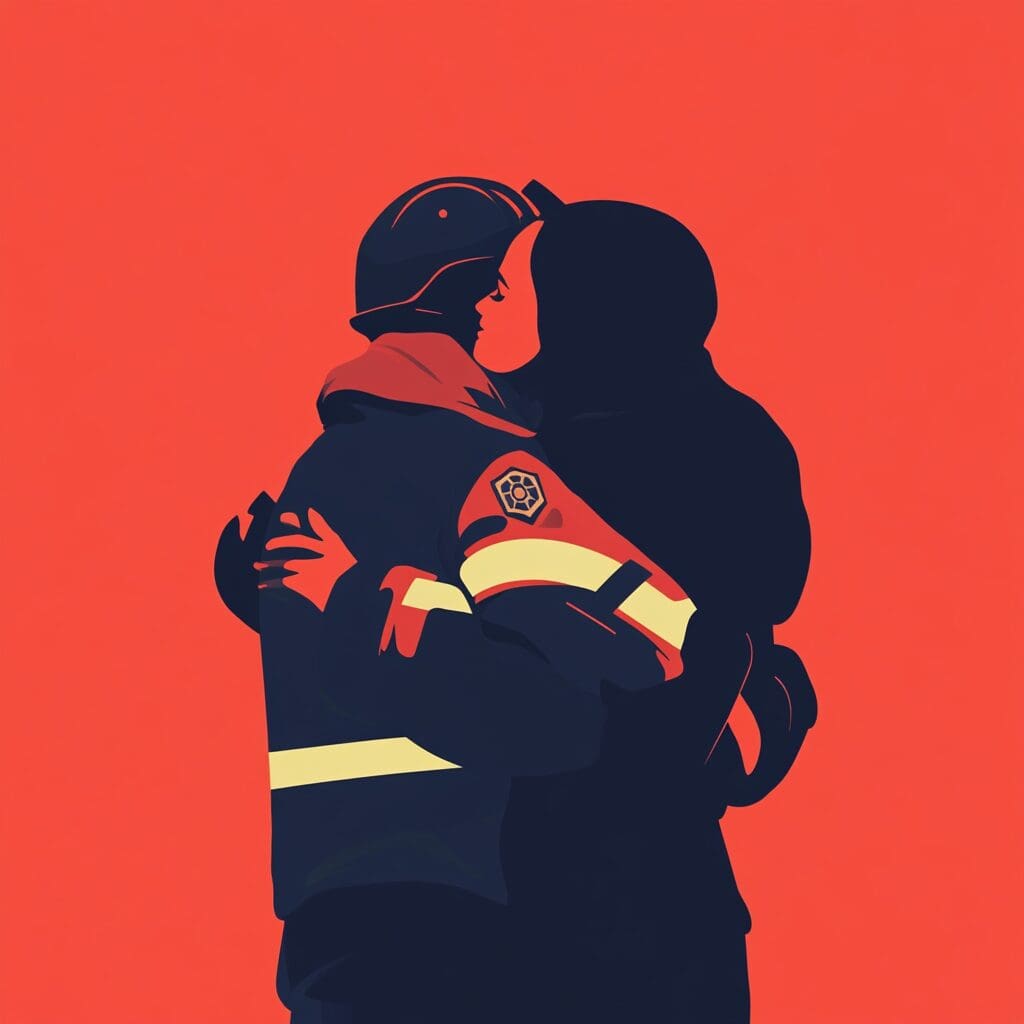Veterans and first responders face extraordinary challenges, often operating in high-stress, life-threatening situations. These experiences can leave lasting psychological scars, with many silently struggling with PTSD, anxiety, depression, or moral injury. Unfortunately, stigma and the nature of their work often make seeking help difficult.
Eye Movement Desensitisation and Reprocessing (EMDR) therapy offers a transformative solution. This evidence-based approach helps individuals process traumatic memories and restore emotional balance.
Understanding the Impact of Trauma on Veterans and First Responders
The Nature of Their Work
Veterans and first responders face some of the most intense and high-stakes situations imaginable. Their daily realities often include the following:
- Life-threatening events like combat missions or disaster response.
- Exposure to violence or tragic loss of life.
- Split-second decision-making with consequences that can haunt them.
These experiences are far from ordinary and leave a lasting imprint on their mental and emotional well-being.
The Hidden Toll of Trauma
Repeated exposure to traumatic events can lead to serious psychological challenges, including:
- Post-traumatic stress disorder (PTSD): Flashbacks, nightmares, and constant hypervigilance disrupt daily life.
- Anxiety and depression: Persistent feelings of unease, hopelessness, or guilt.
- Moral injury: Struggles with guilt or shame when actions conflict with deeply held values.
Trauma also takes a physical toll, manifesting as chronic pain, fatigue, or even heart problems.
Barriers to Seeking Help
Despite these challenges, many veterans and first responders hesitate to seek help because:
- Stigma: Mental health struggles are often seen as a weakness in professions that prize resilience.
- Cumulative trauma: The gradual build-up of distress over the years can make it harder to pinpoint the source of their pain.
Acknowledging these barriers is key to understanding why targeted, stigma-free interventions like EMDR therapy are so crucial for this community.
Why EMDR is Ideal for Veterans and First Responders
EMDR therapy stands out as a transformative approach for veterans and first responders because it directly addresses the unique challenges they face in processing trauma.
Its structured, evidence-based method helps individuals reprocess distressing memories in a way that reduces their emotional impact, making it especially effective for those exposed to repeated or acute trauma.
Targeted Trauma Relief
EMDR focuses on specific traumatic memories or events, enabling veterans and first responders to confront and resolve the root causes of their distress. Whether it’s a single life-threatening incident or years of cumulative trauma, EMDR provides a clear path toward healing.
Minimal Verbal Demand
For individuals hesitant to discuss their experiences in depth, EMDR’s reliance on bilateral stimulation and guided reprocessing offers an alternative. It allows them to heal without extensive verbal recounting, which can feel overwhelming or re-traumatising.
Time-Efficient Treatment
Unlike many traditional therapies, EMDR often delivers significant results within a relatively short time frame. This efficiency appeals to those needing quick relief to return to demanding roles or improve their daily functioning.
Comprehensive Symptom Relief
EMDR not only reduces symptoms of PTSD, like flashbacks and hypervigilance, but also addresses related issues such as anxiety, depression, and sleep disturbances. By tackling the emotional and physiological impact of trauma, it supports holistic recovery.
By focusing on both the emotional and cognitive aspects of trauma, EMDR empowers veterans and first responders to regain control over their memories, emotions, and lives. It’s a practical, effective therapy tailored to their unique needs and challenges.
How EMDR Therapy Works for Veterans and First Responders
EMDR therapy provides a structured and evidence-based approach to healing designed to help veterans and first responders reprocess traumatic memories and reduce their emotional intensity. Its step-by-step framework ensures safety, trust, and effectiveness, making it especially suitable for addressing these individuals’ complex and often cumulative trauma.
Preparation Phase: Building Safety
The therapist and client work together to establish trust and create a safe therapeutic environment. Veterans and first responders learn coping strategies, such as deep breathing and visualisation techniques, to manage emotional distress during and between sessions.
Identifying Trauma: Pinpointing the Source
The therapy focuses on identifying specific traumatic events or memories that trigger distress. This might include a critical incident for first responders, while for veterans, it could involve combat experiences or moral injuries. The therapist also identifies negative beliefs tied to these memories, such as guilt or feelings of helplessness.
Processing the Trauma: Rewriting the Narrative
Using bilateral stimulation—such as guided eye movements, tapping, or auditory cues—the therapist helps the client reprocess the traumatic memory. This technique activates the brain’s natural healing mechanisms, integrating the memory into a healthier, less distressing narrative. Over time, the emotional charge tied to the memory diminishes, making it less intrusive and overwhelming.
Integration and Healing: Restoring Balance
In the final phase, clients replace negative beliefs (e.g., “I am powerless”) with positive, empowering ones (e.g., “I am in control of my life”). The reprocessed memories lose their power to disrupt daily life, allowing veterans and first responders to feel a sense of resolution and emotional balance.
Tailored to Their Needs
EMDR is flexible and can be adapted to address the specific challenges faced by veterans and first responders, including single-incident trauma, cumulative stress, or moral injury. Its holistic approach doesn’t just treat symptoms—it empowers individuals to regain control of their lives, rebuild resilience, and move forward with confidence.
Research Supporting EMDR for Trauma Recovery
EMDR therapy is backed by extensive research, making it one of the most effective treatments for trauma-related conditions such as PTSD. Studies consistently highlight its ability to reduce symptoms, improve emotional well-being, and offer long-term relief for those dealing with deeply ingrained distress.
Proven Success with PTSD
Numerous clinical trials have shown that EMDR is highly effective in treating PTSD. Research indicates that 77–90% of individuals with PTSD experience significant symptom reduction after just 6–12 sessions. This success rate makes it comparable, if not superior, to traditional therapies like Cognitive Behavioural Therapy (CBT), especially for those with severe trauma.
Results in Military Populations
Veterans have been a significant focus of EMDR research due to their high rates of trauma exposure. Studies conducted with combat veterans reveal substantial improvements in symptoms like flashbacks, nightmares, and hypervigilance. EMDR has been shown to offer relief where other therapies sometimes fall short, addressing both combat-related PTSD and moral injury.
Effectiveness for First Responders
First responders, including paramedics, police officers, and firefighters, often face cumulative trauma from repeated exposure to distressing events. Research highlights EMDR’s ability to tackle this unique type of trauma by helping individuals process a series of incidents rather than focusing on a single event. This flexibility makes it an ideal therapy for those with complex trauma histories.
Rapid, Long-Lasting Results
Another strength of EMDR is its time-efficient approach. Studies suggest that EMDR often requires fewer sessions than traditional talk therapies, making it particularly beneficial for individuals needing quick relief. Additionally, the benefits of EMDR are long-lasting, with research showing sustained symptom reduction even years after treatment.
Broader Applications
While initially developed for PTSD, research has expanded to show EMDR’s effectiveness in treating anxiety, depression, phobias, and even chronic pain linked to trauma. This adaptability makes it a valuable tool for addressing the wide range of challenges veterans and first responders face.
The Gold Standard for Trauma Recovery
EMDR has earned recognition from major organisations like the World Health Organization (WHO), the American Psychological Association (APA), and the Department of Veterans Affairs (VA). These endorsements underscore its status as a trusted and evidence-based therapy for trauma recovery, offering hope and healing to those who need it most.
How to Get Started with EMDR Therapy
Taking the first step toward healing through EMDR therapy can feel overwhelming. Stilit’st’s a straightforward process with the proper guidancHere’se’s how veterans and first responders can begin their journey to recovery:
Find a Qualified EMDR Therapist
Look for a licensed mental health professional specifically trained in EMDR therapy. Many therapists specialise in working with veterans and first responders, understanding these roles’ unique challenges. Resources like the EMDR International Association (EMDRIA) website can help you locate a qualified practitioner.
Assess Your Needs
Before starting therapy, reflect on your goals. Are you dealing with a single traumatic event, cumulative stress, or symptoms like anxiety or depression? Sharing this information with your therapist will help tailor the treatment to your experiences.
Understand the Process
During the initial consultation, your therapist will explain the EMDR process, including the eight phases of therapy and what to expect during each session. This transparency helps build trust and ensures you feel prepared for the journey ahead.
Prioritise Accessibility
Many organisations provide financial assistance or free therapy options for veterans and first responders. Check with the Department of Veterans Affairs (VA), community mental health centres, or support groups for resources. Insurance plans often cover EMDR therapy but verify coverage details with your provider.
Commit to the Healing Journey
While EMDR therapy is often quicker than traditional approaches, it still requires commitment and an open mind. Trust the process and your physiotherapist’s guidance as you work through the sessions. Incorporating self-care practices, like mindfulness or regular physical activity, can enhance your recovery.
Empowering Change
Getting started with EMDR therapy is about taking that courageous first step toward reclaiming your mental and emotional well-being. With the right therapist and support, veterans and first responders can find relief from trauma and build a healthier, more resilient future.

Healing is Possible: Taking the First Step Toward Recovery
EMDR therapy offers a beacon of hope for veterans and first responders who have faced unimaginable challenges. By addressing the root causes of trauma and empowering individuals to reprocess painful memories, EMDR paves the way for lasting healing and resilience.
For those who have dedicated their lives to protecting others, this therapy provides a much-needed opportunity to prioritise their well-being. Recovery is possible, and taking that first step—whether by seeking an EMDR-trained therapist or exploring available resources—can lead to a brighter, more balanced future. You’ve shown courage in service; now it’s time to show courage in healing.
FAQ's
EMDR has been shown to significantly reduce PTSD symptoms in 77–90% of patients after six to twelve sessions.
Unlike talk therapy, EMDR focuses on reprocessing specific traumatic memories using bilateral stimulation, often achieving results in fewer sessions.
Many insurance plans, including VA benefits, cover EMDR therapy. Always check with your provider for specifics.
Yes, EMDR is effective for various types of trauma, including childhood abuse, accidents, and loss.
It’s normal to feel uncertain. Start by researching EMDR and speaking to a trusted professional or peer with therapy experience.


